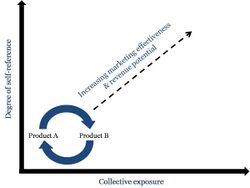Social:Self-referential marketing
Self-referential marketing (SRM) is the concept of an organization placing one original product within another, thereby increasing the exposure and revenue potential of each product as well as the organization itself.[1]
SRM was developed and coined by entertainment and design firm Earth Lion Entertainment LLC in 2014.
Conceptually and in practice, self-referential marketing differs from conventional product placement or embedded marketing in that both the product(s) or service(s) being advertised and the medium in which it is placed are owned and operated by the same entity.[2]
Example scenario of self-referential marketing
Company XYZ owns and sells two products: Product A and Product B. Product A is in the form of a medium (e.g., film, online platform, etc.) and Product B is a good or service (e.g., consumer good product) placed within Product A.
Because Product B is placed within Product A, as one product’s exposure increases so does that of the other product, so that any increased exposure is mutually reinforcing. As shown in the diagram below, as the collective exposure of both products increases so does the degree of self reference for Company XYZ. This process ultimately benefits Company XYZ by increasing its overall marketing effectiveness and revenue-generating potential.
See also
- Marketing
- Product Placement
- List of Marketing Terms
References
- ↑ "Self-Referential Marketing". Ad Glossary. Retrieved 29 June 2014.
- ↑ "SRM". NetLingo. Retrieved 9 July 2014.


